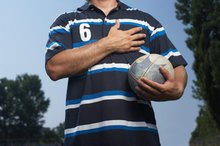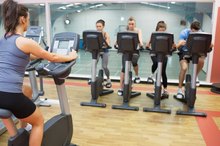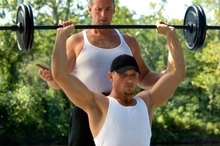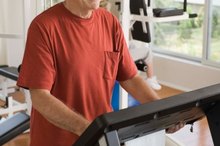Side Effects of Exercise With a Cardiac Pacemaker
Having a cardiac pacemaker put in typically does not affect an active lifestyle, according to the American Heart Association. Side effects usually occur only if the pacemaker is not operating properly or the underlying condition worsens. Before starting any exercise program, consult your doctor and undergo post-operative and pre-exercise testing. Avoiding certain types of exercise and environments can extend the life of your pacemaker and insure its proper functioning.
If you are experiencing serious medical symptoms, seek emergency treatment immediately.
Side Effects
People with cardiac pacemakers are usually able to return to their pre-implantation lifestyle, including active exercise, according to the American Heart Association. Some side effects to watch out for -- especially during the six- to seven-week surgical recovery period -- are breathlessness or fatigue, twitching of the chest muscles, and excessive or prolonged hiccuping. An unexpected increase in heart rate or a slower-than-normal pulse rate can also be signals of abnormality. In other words, contact your physician immediately if any of the symptoms of your particular heart problem occur during exercise after you receive a pacemaker.
- People with cardiac pacemakers are usually able to return to their pre-implantation lifestyle, including active exercise, according to the American Heart Association.
- An unexpected increase in heart rate or a slower-than-normal pulse rate can also be signals of abnormality.
Exercises to Avoid
The Best Exercises for a Deconditioned Heart
Learn More
Avoid playing full-contact sports, advises the Heart Rhythm Society, since high impact to the surgical location can damage the pacemaker or its wiring. Also stay away from exercises that require straining or holding your breath, or activities that require explosive movements such as certain forms of weightlifting -- for example, kettlebells or shoulder presses -- and racquetball or tennis.
Before You Exercise
The Cardiac Athletes website notes that a thorough post-op electrocardiogram six or seven weeks after pacemaker implantation and surgical recovery is essential before starting exercise. Your physician can develop a monitored exercise regime based on the results. Once your doctor adjusts your pacemaker to account for increased and variable heart rate changes, he can clear you to exercise on your own.
Considerations
Heart Arrhythmia & Exercise
Learn More
Spending at least 15 minutes both warming up and cooling down, advises Cardiac Athletes. Some motions and postures — certain yoga stretches, golf swings and shoulder presses, for example — can damage the pacemaker. This type of movement, sometimes called a clavicular pinch, can compress the area where the pacemaker or its wiring is located.
Monitor your heart activity during exercise to prevent potential side effects. If chest tightness or pain occurs during exercise, rest for five minutes before resuming physical activity. If tightness or pain does not subside, contact your physician immediately.
Schedule regular checks of your pacemaker to determine battery wear and to adjust it for changing fitness levels and exercise demands.
- Spending at least 15 minutes both warming up and cooling down, advises Cardiac Athletes.
- If chest tightness or pain occurs during exercise, rest for five minutes before resuming physical activity.
Related Articles
References
- Kotsakou M, Kioumis I, Lazaridis G, et al. Pacemaker insertion. Ann Transl Med. 2015;3(3):42. doi:10.3978/j.issn.2305-5839.2015.02.06
- American Heart Society. Devices that may interfere with ICDs and pacemakers. Updated September 30, 2016.
- Epstein AE, DiMarco JP, Ellenbogen KA, et al. ACC/AHA/HRS 2008 guidelines for device-based therapy of cardiac rhythm abnormalities: A report of the American College of Cardiology/American Heart Association Task Force on Practice Guidelines (Writing Committee to Revise the ACC/AHA/NASPE 2002 Guideline Update for Implantation of Cardiac Pacemakers and Antiarrhythmia Devices) developed in collaboration with the American Association for Thoracic Surgery and Society of Thoracic Surgeons. J Am Coll Cardiol 2008; 51:e1. doi:10.1016/j.jacc.2008.02.032
- Hauser RG, Hayes DL, Kallinen LM, Cannom DS, Epstein AE, Almquist AK, Song SL, Tyers GF, Vlay SC, Irwin M. Clinical experience with pacemaker pulse generators and transvenous leads: an 8-year prospective multicenter study. Heart Rhythm. 2007 Feb;4(2):154-60. doi:10.1016/j.hrthm.2006.10.009
Writer Bio
A freelance writer for more than 30 years, D.M. Gutierrez has had nonfiction, fiction and poetry published in women's, mystery, academic, children's, disability and teen print publications and websites including "Psychological Reports" and "Highlights for Children." She has an advanced degree in psychology from the University of California at Davis.









